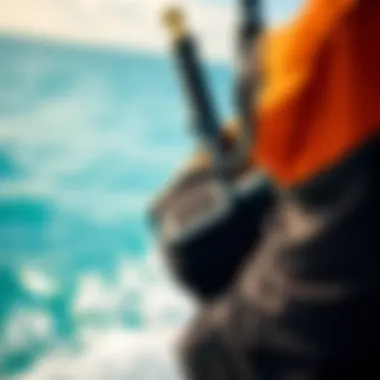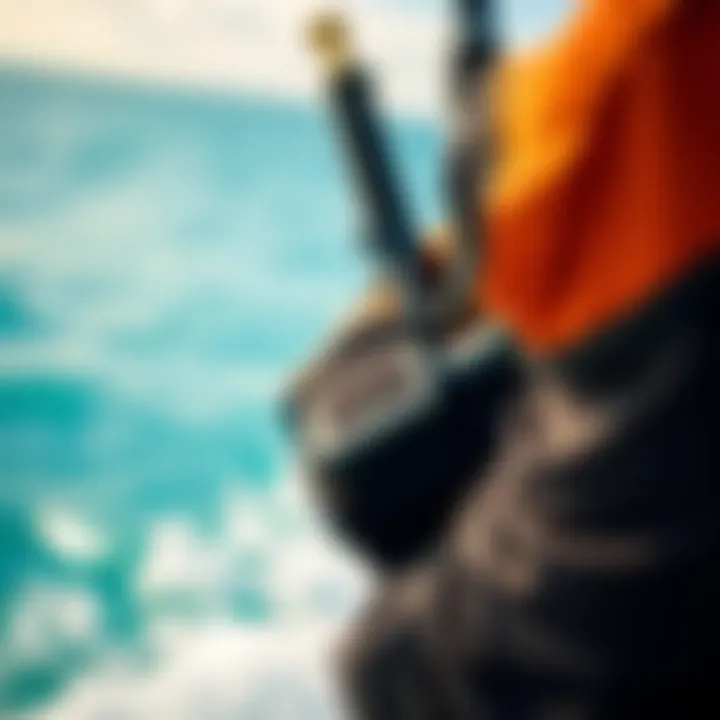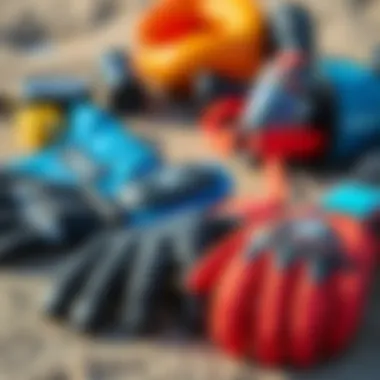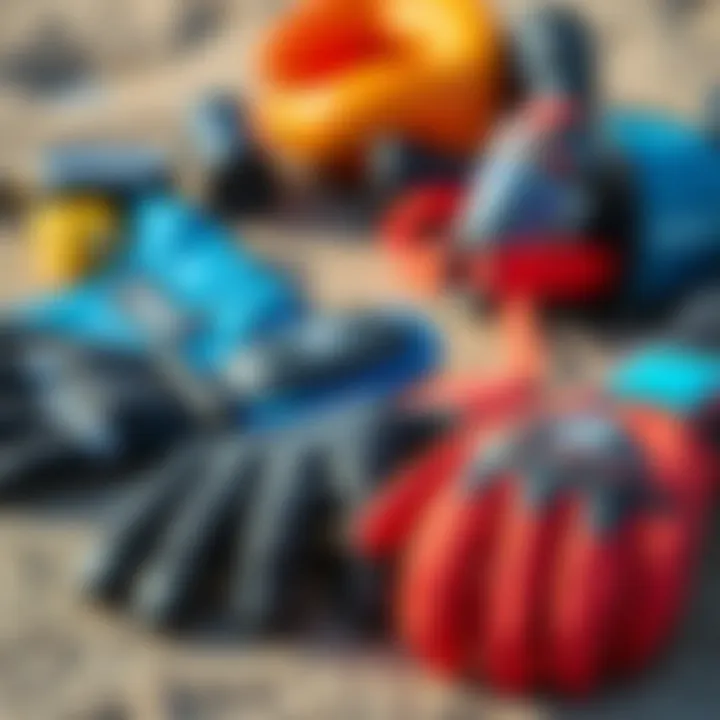The Impact of Thin Neoprene Gloves in Kiteboarding


Intro
Kiteboarding is not just a sport; it's an adventure that combines the exhilaration of wind and water with the skill of maneuvering a board beneath your feet. As exhilarating as it is, the experience can also be harsh on the body, particularly the hands which bear the brunt of control. This is where thin neoprene gloves step in, playing a vital role in enhancing the kiteboarding experience.
These gloves aren’t merely an accessory; they’re an essential piece of gear that empowers riders to grip and control their equipment more effectively while protecting against the chilly bite of the water and wind. Understanding their material properties and functional advantages can create a noticeable difference for both novices and seasoned kiteboarders alike.
In this article, we will explore everything that makes thin neoprene gloves a significant addition to your kiteboarding gear. From discussing the key attributes that set them apart, to diving into practical considerations for selection, we aim to provide a comprehensive guide that emphasizes grip, thermal protection, and overall comfort for kiteboarders.
Additionally, we'll delve into various styles available for different conditions and add in some tips and techniques to help enhance your overall kiteboarding experience. Let’s embark on this journey to better understand how thin neoprene gloves can elevate your kiteboarding skills.
Prelude to Thin Neoprene Gloves
Thin neoprene gloves serve as a pivotal accessory for kiteboarders, intricately blending functionality with comfort. As any seasoned kiteboarder will tell you, equipment not only enhances performance but also ensures safety during your adventures. Designed to withstand the rigors of harsh conditions while providing essential features, these gloves are tailored for those who crave the thrill of riding the waves.
Why Neoprene?
Neoprene, a material synonymous with water sports, presents itself as a champion against water and cold temperatures. The very essence of kiteboarding lies in the embrace of the ocean; thus, having the right gear can make or break your experience. Thin neoprene gloves offer a snug fit that minimizes water entry while allowing for dexterity, which is key when handling lines and bars. They offer the balance needed to feel in control without sacrificing warmth.
Benefits of Thin Neoprene Gloves
- Grip and Control
One of the primary benefits of thin neoprene gloves is their superior grip. The textured surfaces of these gloves enhance your grasp on the control bar, a crucial component of kiteboarding. A secure grip not only boosts confidence but also helps in executing precise maneuvers, particularly during challenging conditions. - Thermal Protection
Another undeniable advantage is thermal protection. The thin layer of neoprene acts as an insulator, guarding your hands from the biting cold of the water. Kiteboarding can expose you to brisk winds and frigid waves, and maintaining your body heat is fundamentally vital. - Comfort
Comfort during long sessions is an aspect that cannot be overlooked. Thin neoprene gloves are designed to fit snugly yet comfortably, reducing the likelihood of blisters and ensuring you can focus on your kiteboarding techniques without the irritation of your gear.
Key Considerations
Before investing in thin neoprene gloves, consider aspects like fit, flexibility, and personal preference. Opt for gloves that cater to your specific needs and the environments in which you kiteboard.
"The right gear makes all the difference between an exhilarating ride and a discomforting struggle on the water."
Lastly, understanding the importance of thin neoprene gloves in kiteboarding comes down to how they optimize your performance while safeguarding your experience. This introductory section paves the way for deeper exploration into the material properties and other significant roles these gloves play in ensuring you have a fulfilling and safe kiteboarding adventure.
Material Properties of Neoprene
The material properties of neoprene play a vital role in the performance and comfort of kiteboarders. Understanding these properties can significantly influence the selection of gloves, ensuring that enthusiasts can perform at their best while enjoying the thrills of the water.
Composition of Neoprene
Neoprene, chemically known as polychloroprene, is a synthetic rubber that combines various elements to create a versatile material. This blend typically includes:
- Chloroprene Monomer: The core ingredient that gives neoprene its distinctive properties.
- Additives: These may include stabilizers, curing agents, and fillers which enhance performance and durability.
The result is a material that is not only flexible but also resistant to environmental damages. Its water-resistant nature ensures that water sports enthusiasts can enjoy their activities without compromising on grip or comfort. Moreover, the varying thicknesses and densities of neoprene available in gloves allow users to select an appropriate option for specific water conditions, keeping them safe and functional.
Benefits of Neoprene in Water Sports
The advantages of neoprene in water sports are numerous, especially when it comes to kiteboarding. Here are some key benefits:
- Thermal Insulation: Neoprene traps a thin layer of water between the glove and the skin, which quickly warms up with body heat, keeping hands warm in cold conditions.
- Flexibility and Dexterity: The inherent stretchiness of the material allows for a natural range of motion, which is crucial when handling kite lines or adjusting gear mid-air.
- Resistance to Saltwater and UV Rays: Neoprene's structure helps it withstand the damaging effects of saltwater and consistent sun exposure, prolonging the life of the gloves.
"Choosing neoprene for water sports gear isn’t just about function, it’s about making sure you stay comfortable and safe while doing what you love."


- Durability: Neoprene gloves tend to be resistant to wear and tear, making them an economical choice for kiteboarders who often find themselves navigating rugged conditions.
- Improved Grip: Many neoprene gloves are designed with textured surfaces that enhance grip, allowing for better control when maneuvering a kite in challenging situations.
Neoprene’s balance of comfort, functionality, and durability is why it has become a favored choice among kiteboarders, ensuring that they can push their limits while maintaining full control in the process.
Why Choose Thin Neoprene Gloves?
In the world of kiteboarding, every piece of gear matters, and thin neoprene gloves are no exception. When you’re out on the water, you need to be fully equipped to handle the changing conditions. The unique properties and design of these gloves make them an essential choice for anyone serious about their performance in kiteboarding.
These gloves provide several clear advantages, including enhanced grip, thermal protection, and increased comfort. Each of these elements plays a significant role in optimizing both your experience and safety while enjoying the thrill of kiteboarding.
Enhanced Grip and Control
One key feature of thin neoprene gloves is their ability to enhance grip. Kiteboarding requires a solid hold on the control lines and bar. The last thing you want is to lose your grip in a pivotal moment, such as during a jump or a quick maneuver. Thin neoprene gloves grip the surface exceptionally well thanks to their texture and materials.
The gloves often have rubberized patterns or a textured surface that stick to your hands like glue. This means you can adjust your kite without losing precious control. In high winds or choppy waters, having that reliable grip can be the difference between soaring in the sky or taking a tumble. The focus on grip allows kiteboarders to maneuver more confidently, enhancing overall performance.
Thermal Protection Against Cold Water
Water temperature isn't always a cozy factor when kiteboarding. Depending on the season and geography, you could easily find yourself in chilly situations. Thin neoprene gloves serve as a barrier against the cold. They keep your hands warm, allowing you to remain agile and ready for action, even in lower temperatures.
Ignoring cold water can lead to numbness in fingers, which drastically reduces your control. The insulating qualities of neoprene act as a shield, providing enough warmth while remaining lightweight. This combo makes them perfect for cooler climate enthusiasts, ensuring you can focus on your skills rather than fighting off the cold.
Increased Comfort During Use
Comfort is paramount when engaging in any physical activity. Thin neoprene gloves are designed for a snug yet comfortable fit, allowing for full range of motion without feeling overly restrictive. Whether you’re riding for hours or just enjoying some recreational kiteboarding, comfort plays a huge role in your stamina and enjoyment.
These gloves minimize chafing or discomfort that would normally come from prolonged use. More so, they fit closely around the wrist to prevent water from seeping in, keeping your hands dry and comfortable. A good pair of gloves can improve not only your grip and warmth but also your overall confidence to push your limits.
"Comfort, grip, and warmth are not just nice-to-haves; they're essentials for success on the water."
By choosing thin neoprene gloves, kiteboarders are making a savvy decision that impacts their performance significantly. With grip that holds, insulation from the chill, and an overall feel that promotes prolonged engagement, these gloves prove their worth in every session.
Different Styles of Thin Neoprene Gloves
When it comes to kiteboarding, selecting the right gear can make or break your experience on the water. This holds true particularly for gloves, which might seem like a small accessory but play a pivotal role in performance and comfort. The diverse styles of thin neoprene gloves cater to specific needs and preferences, enhancing grip, warmth, and flexibility while also considering factors like weather conditions and personal comfort.
Choosing between these styles isn’t just about looks; it’s about functionality. Understanding the different designs helps kiteboarders make informed decisions that can significantly impact their ride.
Full Finger vs. Half Finger Designs
The choice between full finger and half finger gloves is one that many kiteboarders grapple with. Each design comes with its own set of advantages.
Full finger gloves cover the entire hand, providing extra warmth and protection against the chill of the water. This is especially important for those chilly morning sessions or windy days when the air is brisk. They are beneficial in preventing skin abrasions if you happen to fall or get dragged on the water. Furthermore, full finger gloves can enhance grip as well, preventing any slipping during maneuvers.
In contrast, half finger gloves allow for greater dexterity, making them ideal for those sunny afternoons when a full dose of warmth is not necessary. They grant the ability to feel the bar more vividly, offering improved handling and control. This can be especially advantageous for precise movements or intricate tricks where feedback from your hands plays a crucial role. However, one must consider the trade-off regarding insulation and protection.
"Your hands are the bridge between you and the kite; investing in the right gloves is tantamount to ensuring you have a smoother ride."
Wrist-Closure Mechanisms
The wrist-closure mechanism is another detail that shouldn’t be overlooked. The way a glove secures around the wrist can greatly influence both comfort and practicality.


Velcro straps are a popular choice due to their adjustability. They let you customize the tightness, ensuring a snug fit that keeps water out without restricting circulation. This is particularly useful when you're out riding for extended periods, as a well-fitted glove helps to maintain circulation, avoiding that dreaded numbness that can come from too much constriction.
Another option includes elastic cuffs, which provide a more streamlined look. While they are often less adjustable than velcro, they do tend to offer smooth, comfortable wrapping around the wrist without the bulkiness of fastening material. It often boils down to personal preference: adjustable options do the trick for those who value versatility, while elastic fits might be better for those prioritizing ease.
Evaluating Glove Fit and Sizing
In the realm of kiteboarding, where performance largely hinges on comfort and control, the significance of evaluating glove fit and sizing cannot be overstated. The right fit offers several benefits, impacting not only your technique but also your safety on the water. When gloves are too tight, they can hinder dexterity; too loose, and you risk losing grip or even having gloves slip off during action. Finding a glove that fits snugly while allowing for mobility is essential for any kiteboarding enthusiast, whether you are carving through waves or harnessing the wind's power.
Importance of Proper Fit
A proper fit in thin neoprene gloves ensures that your hands remain agile. You've probably heard that a chain is only as strong as its weakest link, and in this scenario, your gloves are the link between you and your equipment. Ill-fitting gloves can create friction points on your palms and fingers, which may lead to blisters during prolonged use. Additionally, the level of thermal protection offered diminishes when gloves aren't snug. Water can sneak in through gaps, turning your hands into frozen blocks, which translates to a diminished performance on the board.
Moreover, a good fit also sharpens your grip on the bar. When every micro-movement matters—be it adjusting your stance or maneuvering your kite—stability is crucial. Gloves that fit well lend more than just warmth; they assure greater control, allowing you to feel every subtle feedback from your kite and board.
Measuring for Size Accuracy
Measuring for size accuracy transcends mere guesswork. It’s a straightforward process that can save you time and enhance your kiteboarding experience. Typically, glove sizes correspond to hand measurements in inches or centimeters. To measure accurately, follow these simple steps:
- Measure the Width: Use a tape measure to find the circumference around the widest part of your palm, just below the knuckles. Make sure to keep your hand relaxed, as tension can distort the measurement.
- Measure the Length: Measure from the tip of your longest finger to the base of your palm. This measurement ensures the fingers have adequate room without being overly baggy.
- Consult Size Charts: Every brand may have slightly different sizing charts. Always refer to the specific brand’s size guide to connect your measurements with the right size.
In the end, not getting the right size is like putting on shoes two sizes too big—it’s uncomfortable at best and dangerous at worst. Taking the time to measure correctly can make all the difference in ensuring your gear works in harmony with your skills on the water.
Remember: A snug fit adds to your performance and safety. Above all, comfort and feeling are paramount when chasing the perfect ride.
By emphasizing proper fit and size measurement in selecting thin neoprene gloves, kiteboarding lovers can ensure a smoother ride and safer experiences on the water. Feeling confident in your gear allows you to focus on what matters most—the thrill of the sport.
Maintenance and Care for Thin Neoprene Gloves
Proper maintenance and care of thin neoprene gloves is crucial for ensuring their longevity and performance. As kiteboarders exposed to various elements of nature, neglecting these gloves could lead to diminished functionality and, ultimately, an unsafe experience on the water. Taking the time to care for your gloves not only enhances their durability but also contributes to your overall enjoyment while kiteboarding.
Cleaning Recommendations
When it comes to cleaning thin neoprene gloves, there are some straightforward yet effective practices you can adopt. Here are a few pointers to keep your gloves in good condition:
- Rinse after use: Always rinse your gloves with fresh water immediately after coming out of the surf. Saltwater, sand, and other debris can cause degradation over time, so it’s essential to wash away any contaminants as soon as possible.
- Use mild detergent: If your gloves are particularly dirty, mix a small amount of mild soap with fresh water. Gently scrub the gloves with your hands, ensuring not to use abrasive materials that could damage the fabric. Rinse them thoroughly afterward to avoid any soap residue.
- Avoid heat sources: Once cleaned, never place your gloves in direct sunlight or use a dryer. High temperatures can deform the neoprene, leading to a poor fit and reduced protective qualities. Instead, lay them flat or hang them in a shaded area to air dry.
Careful attention to cleaning can extend the lifespan of your gloves, ensuring you always have dependable protection as you ride the waves.
Storage Practices
When your gloves are not in use, how you store them matters just as much as how you clean them. Here are some strategies for proper storage of thin neoprene gloves:
- Keep them dry: Make sure your gloves are completely dry before storing them. Moisture trapped inside can lead to mold and mildew, deteriorating the neoprene material.
- Avoid folding: Always store your gloves flat or rolled gently instead of folding them. This prevents creases that could weaken the material over time.
- Choose a cool location: Like heat, extreme cold can also impact the neoprene. Find a cool, dry place for storage, away from direct sunlight and sharp objects that could puncture or scratch the surface.
By integrating these cleaning and storage practices into your routine, you ensure that your thin neoprene gloves remain effective. This focus on maintenance minimizes the risk of wear and tear, allowing you to ride with confidence.
"Investing a little time in the care of your gear pays dividends in performance."
Common Misconceptions Regarding Neoprene Gloves
Kiteboarding, while thrilling, comes with its own set of challenges, particularly when it comes to maintaining comfort and safety in varying weather conditions. Thin neoprene gloves are often hailed as essential gear, yet misunderstandings about their properties and performance can deter some enthusiasts from investing in them. This section aims to clarify these common misconceptions, emphasizing the importance of accurate information for kiteboarders and occasional adventurers alike.


Myths About Durability
One prevalent myth floating around the kiteboarding community relates to the durability of thin neoprene gloves. Many believe that because these gloves are designed to be lightweight and flexible, they are inherently less durable than bulkier options. This simply isn't true.
Thin neoprene gloves are crafted from high-quality materials that actually provide a fair amount of resilience. The unique properties of neoprene allow it to withstand wear and tear while maintaining flexibility. When properly cared for, thin gloves can hold their own against rocks, sand, and the rigors of regular use.
- Proper Care: To extend the lifespan of your gloves, rinse them promptly after each use to remove salt and sand. This simple step can prevent degradation of the material.
- Quality Matters: Choosing a reputable brand can influence durability. Some manufacturers use advanced techniques to enhance wear resistance, ensuring that you’re not just buying a pair of gloves, but a reliable piece of gear.
It's essential not to underestimate the blend of durability and comfort that thin neoprene gloves can provide. Their design does not imply fragility but rather an intelligent approach to balancing performance with user comfort.
Heat Retention Myth
Another misconception is that thin neoprene gloves do not provide adequate heat retention. Many kiteboarders worry that because the gloves are slim, they won't keep their hands warm in colder waters. This belief stems from an oversight of how neoprene actually functions in terms of thermal insulation.
In reality, the insulation properties of neoprene are quite impressive, even in thinner designs.
"Neoprene provides warmth by trapping a thin layer of water between your skin and the glove, which is then warmed by body heat."
This means that as long as the gloves fit snugly, you're likely to experience sufficient warmth. It’s also worth noting that:
- Layering Matters: For colder conditions, consider wearing thicker neoprene gloves or layering with other thermal gear for added protection.
- Fit Is Key: A well-fitting glove that creates that essential water barrier will retain heat better than a loose-fitting one that allows cold water to seep in.
Understanding these misconceptions can significantly affect the choices kiteboarders make regarding their gear. By clearing up the myths surrounding the durability and heat retention of thin neoprene gloves, enthusiasts can make more informed decisions, thus enhancing their overall kiteboarding experience. Whether you're an instructor teaching the basics or a recreational athlete, recognizing the value of these gloves can be a game-changer in maintaining safety and comfort on the water.
Exploring the Role of Neoprene in Kiteboarding
In the dynamic world of kiteboarding, equipment choices can make or break your ride. Among these choices, thin neoprene gloves play a significant role that often goes unrecognized. It's not merely a matter of style; these gloves can actually fine-tune performance while ensuring safety on the water. This section embraces an in-depth look at how neoprene, with its distinctive qualities, contributes to an enhanced experience for kiteboarders from all walks of life.
Impact on Performance
Performing at your best in kiteboarding hinges on the right balance of comfort and functionality. Thin neoprene gloves are particularly designed to provide enhanced grip without sacrificing dexterity. When gripping the control bar, kiteboarders need to ensure that there’s a strong connection, whether tussling with the wind or maneuvering through waves. These gloves offer an almost second-skin feel, allowing for subtle adjustments that keep a rider in perfect sync with their kite. As many seasoned riders will attest, the warmth that neoprene provides can help prevent an otherwise frustrating loss of focus due to cold fingers. Keeping those hands warm enables kiteboarders to maintain the finesse they need while navigating through varying conditions.
The flexibility of thin neoprene also allows for a full range of motion, which is crucial when you’re making instinctual adjustments during intense riding sessions. By using gloves that fit snugly and move with your hands, you’re reducing the risk of clumsy mistakes that could lead to wipeouts or hard landings. In summary, the right gloves can boost your performance by ensuring your hands remain agile, warm, and firmly grasp the control bar, making for a smoother and more enjoyable session.
Safety Enhancements
Kiteboarding isn't merely about fun on the water; there's always an element of risk present, especially when navigating breezy conditions or unforeseen obstacles. Thin neoprene gloves enhance safety in several ways. Firstly, they offer protection against potential injuries associated with kite lines and rapid motion. No one wishes to end their session with a nasty rope burn or laceration. The additional layer of neoprene can act as a shield against these risks, letting kiteboarders focus on their ride instead of worrying about minor injuries.
Furthermore, there's a misconception that safety gear is bulky or limits performance. Thin neoprene gloves counteract this myth perfectly; they provide a barrier against accidents without feeling cumbersome. When you need to react quickly, having mobility in your hands can be invaluable. A quick adjustment, a tug on the line, or an effort to stabilize oneself during a gust of wind all require agility, which the right gloves facilitate.
To sum up, using thin neoprene gloves in kiteboarding serves to enhance both performance and safety. As kiteboarders, having gear that improves both feels crucial in tackling those winds with confidence. This combination makes them not just an accessory, but a vital part of kiteboarding gear.
End
As we wrap up our discussion on thin neoprene gloves in kiteboarding, it's clear that these gloves are critical tools for any serious kiteboarding enthusiast. They serve several important roles that can significantly enhance both performance and safety.
First off, their ability to improve grip can’t be understated. When you’re dealing with the unpredictable forces of water and wind, having solid control of your equipment is paramount. Thin neoprene gloves provide that extra tactile sensitivity that can make all the difference in those crucial moments, where split-second decisions count.
Thermal protection is another notable aspect. Water can be relentlessly cold, especially during early morning or late evening sessions. The gloves create a barrier against frigid temperatures, allowing riders to stay longer on the water without succumbing to discomfort or hypothermia. In kiteboarding, time spent on the water is often directly correlated with enjoyment and skill acquisition.
Another element to consider is the comfort factor. Extended exposure to the elements can detract from the overall experience, leading to fatigue and decreased focus. Thin neoprene gloves excel in their supportive fit, cushioning your hands and allowing for natural movement. This comfort translates to improved concentration on riding techniques rather than battling any discomfort.
It’s also worth noting that different styles and configurations of gloves can cater to specific kiteboarding conditions. Whether it’s the choice between full or half-finger designs, each option serves a unique purpose and offers advantages depending on the weather and the rider’s preference.
Ultimately, selecting the right pair of thin neoprene gloves involves not just understanding their material properties and features but aligning them with personal preferences and riding conditions. This guide showcases that knowledge is power, and with the right tools, kiteboarders can unleash their full potential on the water.
In summary, investing in quality thin neoprene gloves is not just an accessory purchase; it's a strategic decision that promotes better performance, safety, and overall enjoyment. For every kiteboarder who values experience, these gloves are not merely protective gear—they’re essential equipment for navigating the thrilling world of kiteboarding.



